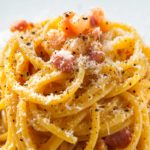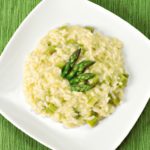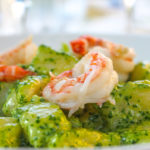THE BIRTH OF CARBONARA PASTA

Carbonara pasta is a typical Roman dish. Full of taste and very easy to make, its goodness is thanks to quality ingredients. Be that as it may, it seems that originally, the ingredients were different.
Legend has it that in the Rome of WWII, occupied by allied troops, a local innkeeper was asked to make food for some American soldiers who gave him bacon and powdered eggs from their military supplies. The best way to feed a lot of people with few ingredients is making pasta, so the innkeeper combined these few ingredients to make a dish that is big favourite of Lazio citizens, but it is also loved in many countries.
Later, when things got better and it was possible to have local ingredients again, the recipe was enriched with guanciale (cured pork jowl) and fresh, creamy eggs.
To celebrate Carbonara day, I made spaghetti alla chitarra, reminiscent of Roman tonnarelli (a fresh, long egg pasta) and enjoyed this epicurean dish during this period of quarantine with my husband.
Prep Time: 5 minutes | Cooking Time: 15 minutes | Total Time: 20 minutes | Yield: Makes 2 servings.
Ingredients
For the pasta
- 100 g semolina flour
- 100 g all-purpose flour
- 1 egg
- About ¼ cup water, room temperature
For the sauce
- 3 tbsp grated Parmigiano Reggiano (I did not have Roman Pecorino)
- 2 egg yolks
- 1 egg
- Black pepper
- 60 g guanciale (cured pork jowl)
Instructions
On a wooden pastry board, pour the flour in a mound, make a well in its centre and crack the egg into it. Blend by hand, making a dough that you are going to smooth with a rolling pin. It should be rolled to a 3 mm thickness. Then cut it into rectangles that will be cut on the chitarra.
Cook the pasta in salted water; if it is fresh, it will cook in a few seconds.
You might need to add some flour if the dough is too wet or some water if it is too dry and impossible to work.
TIPS:
As you work it, keep the dough near your belly, when kneading and rolling.
Lean into the dough as you work, exploit gravity, not your shoulders and arms.
In a frying pan, sauté the guanciale in its own fat. While the water for pasta is beginning to boil, I place the egg and egg yolks in a Pyrex or stainless steel bowl and place it over the pot, whisking them until they are fluffy, gradually adding the cheese and a generous sprinkle of black pepper. Remember to keep the bowl away from direct heat to avoid curdling the egg.
When the pasta is cooked, drain it and toss it in the frying pan with the guanciale. Transfer it to the bowl with the egg mixture. Toss until the egg mixture has coated the pasta and enjoy.










